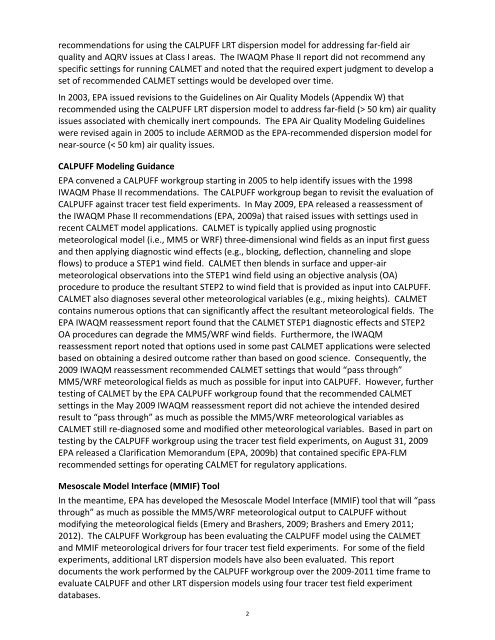Documentation of the Evaluation of CALPUFF and Other Long ...
Documentation of the Evaluation of CALPUFF and Other Long ...
Documentation of the Evaluation of CALPUFF and Other Long ...
Create successful ePaper yourself
Turn your PDF publications into a flip-book with our unique Google optimized e-Paper software.
ecommendations for using <strong>the</strong> <strong>CALPUFF</strong> LRT dispersion model for addressing far‐field air<br />
quality <strong>and</strong> AQRV issues at Class I areas. The IWAQM Phase II report did not recommend any<br />
specific settings for running CALMET <strong>and</strong> noted that <strong>the</strong> required expert judgment to develop a<br />
set <strong>of</strong> recommended CALMET settings would be developed over time.<br />
In 2003, EPA issued revisions to <strong>the</strong> Guidelines on Air Quality Models (Appendix W) that<br />
recommended using <strong>the</strong> <strong>CALPUFF</strong> LRT dispersion model to address far‐field (> 50 km) air quality<br />
issues associated with chemically inert compounds. The EPA Air Quality Modeling Guidelines<br />
were revised again in 2005 to include AERMOD as <strong>the</strong> EPA‐recommended dispersion model for<br />
near‐source (< 50 km) air quality issues.<br />
<strong>CALPUFF</strong> Modeling Guidance<br />
EPA convened a <strong>CALPUFF</strong> workgroup starting in 2005 to help identify issues with <strong>the</strong> 1998<br />
IWAQM Phase II recommendations. The <strong>CALPUFF</strong> workgroup began to revisit <strong>the</strong> evaluation <strong>of</strong><br />
<strong>CALPUFF</strong> against tracer test field experiments. In May 2009, EPA released a reassessment <strong>of</strong><br />
<strong>the</strong> IWAQM Phase II recommendations (EPA, 2009a) that raised issues with settings used in<br />
recent CALMET model applications. CALMET is typically applied using prognostic<br />
meteorological model (i.e., MM5 or WRF) three‐dimensional wind fields as an input first guess<br />
<strong>and</strong> <strong>the</strong>n applying diagnostic wind effects (e.g., blocking, deflection, channeling <strong>and</strong> slope<br />
flows) to produce a STEP1 wind field. CALMET <strong>the</strong>n blends in surface <strong>and</strong> upper‐air<br />
meteorological observations into <strong>the</strong> STEP1 wind field using an objective analysis (OA)<br />
procedure to produce <strong>the</strong> resultant STEP2 to wind field that is provided as input into <strong>CALPUFF</strong>.<br />
CALMET also diagnoses several o<strong>the</strong>r meteorological variables (e.g., mixing heights). CALMET<br />
contains numerous options that can significantly affect <strong>the</strong> resultant meteorological fields. The<br />
EPA IWAQM reassessment report found that <strong>the</strong> CALMET STEP1 diagnostic effects <strong>and</strong> STEP2<br />
OA procedures can degrade <strong>the</strong> MM5/WRF wind fields. Fur<strong>the</strong>rmore, <strong>the</strong> IWAQM<br />
reassessment report noted that options used in some past CALMET applications were selected<br />
based on obtaining a desired outcome ra<strong>the</strong>r than based on good science. Consequently, <strong>the</strong><br />
2009 IWAQM reassessment recommended CALMET settings that would “pass through”<br />
MM5/WRF meteorological fields as much as possible for input into <strong>CALPUFF</strong>. However, fur<strong>the</strong>r<br />
testing <strong>of</strong> CALMET by <strong>the</strong> EPA <strong>CALPUFF</strong> workgroup found that <strong>the</strong> recommended CALMET<br />
settings in <strong>the</strong> May 2009 IWAQM reassessment report did not achieve <strong>the</strong> intended desired<br />
result to “pass through” as much as possible <strong>the</strong> MM5/WRF meteorological variables as<br />
CALMET still re‐diagnosed some <strong>and</strong> modified o<strong>the</strong>r meteorological variables. Based in part on<br />
testing by <strong>the</strong> <strong>CALPUFF</strong> workgroup using <strong>the</strong> tracer test field experiments, on August 31, 2009<br />
EPA released a Clarification Memor<strong>and</strong>um (EPA, 2009b) that contained specific EPA‐FLM<br />
recommended settings for operating CALMET for regulatory applications.<br />
Mesoscale Model Interface (MMIF) Tool<br />
In <strong>the</strong> meantime, EPA has developed <strong>the</strong> Mesoscale Model Interface (MMIF) tool that will “pass<br />
through” as much as possible <strong>the</strong> MM5/WRF meteorological output to <strong>CALPUFF</strong> without<br />
modifying <strong>the</strong> meteorological fields (Emery <strong>and</strong> Brashers, 2009; Brashers <strong>and</strong> Emery 2011;<br />
2012). The <strong>CALPUFF</strong> Workgroup has been evaluating <strong>the</strong> <strong>CALPUFF</strong> model using <strong>the</strong> CALMET<br />
<strong>and</strong> MMIF meteorological drivers for four tracer test field experiments. For some <strong>of</strong> <strong>the</strong> field<br />
experiments, additional LRT dispersion models have also been evaluated. This report<br />
documents <strong>the</strong> work performed by <strong>the</strong> <strong>CALPUFF</strong> workgroup over <strong>the</strong> 2009‐2011 time frame to<br />
evaluate <strong>CALPUFF</strong> <strong>and</strong> o<strong>the</strong>r LRT dispersion models using four tracer test field experiment<br />
databases.<br />
2

















